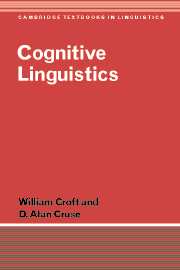Book contents
- Frontmatter
- Contents
- Figures
- Tables
- Preface
- 1 Introduction: what is cognitive linguistics?
- A conceptual approach to linguistic analysis
- Cognitive approaches to lexical semantics
- Cognitive approaches to grammatical form
- 9 From idioms to construction grammar
- 10 An overview of construction grammars
- 11 The usage-based model
- 12 Conclusion: cognitive linguistics and beyond
- References
- Index
- Index
9 - From idioms to construction grammar
Published online by Cambridge University Press: 05 June 2012
- Frontmatter
- Contents
- Figures
- Tables
- Preface
- 1 Introduction: what is cognitive linguistics?
- A conceptual approach to linguistic analysis
- Cognitive approaches to lexical semantics
- Cognitive approaches to grammatical form
- 9 From idioms to construction grammar
- 10 An overview of construction grammars
- 11 The usage-based model
- 12 Conclusion: cognitive linguistics and beyond
- References
- Index
- Index
Summary
Introduction
The cognitive linguistic approach to syntax goes under the name of construction grammar. It is not an exaggeration to say that construction grammar grew out of a concern to find a place for idiomatic expressions in the speaker's knowledge of a grammar of their language. The study of idioms led to calls for a rethinking of syntactic representation for many years before construction grammar emerged, and some of this work will be referred to in this chapter. At least partly independently of construction grammar, a number of researchers have emphasized the need to represent linguistic knowledge in a construction-like fashion. But in cognitive linguistics, these concerns led to a grammatical framework in which all grammatical knowledge is represented in essentially the same way. This chapter presents the arguments for a construction grammar.
Construction grammar, like any other scientific theory, did not arise in a theoretical vacuum. Construction grammar arose as a response to the model of grammatical knowledge proposed by the various versions of generative grammar over the period from the 1960s to at least the 1980s, and other syntactic theories that emerged as direct offshoots of generative grammar. (These models in turn represented extensions of the organization of a traditional descriptive grammar of a language, albeit with significant changes in terminology.)
- Type
- Chapter
- Information
- Cognitive Linguistics , pp. 225 - 256Publisher: Cambridge University PressPrint publication year: 2004
- 2
- Cited by



